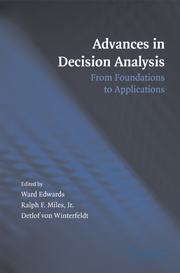Book contents
- Frontmatter
- Contents
- List of Contributors
- Preface
- 1 Introduction
- PART I HISTORY AND FOUNDATIONS OF DECISION ANALYSIS
- PART II STRUCTURING DECISION PROBLEMS
- PART III PROBABILITIES AND BAYES NETS
- PART IV UTILITIES
- PART V RISK ANALYSIS
- PART VI DECISION ANALYSIS IN A BEHAVIORAL AND ORGANIZATIONAL CONTEXT
- PART VII APPLICATIONS OF DECISION ANALYSIS
- 24 The Adoption of Multiattribute Utility Theory for the Evaluation of Plutonium Disposition Options in the United States and Russia
- 25 Choosing a Tritium Supply Technology for Nuclear Weapons: Reflections on a Controversial Decision Analysis
- 26 Applications of Decision Analysis to the Military Systems Acquisition Process
- 27 Balancing Environmental and Operational Objectives in Nuclear Refueling Strategies
- 28 Perspective on Decision Analysis Applications
- Index
- References
24 - The Adoption of Multiattribute Utility Theory for the Evaluation of Plutonium Disposition Options in the United States and Russia
Published online by Cambridge University Press: 05 June 2012
- Frontmatter
- Contents
- List of Contributors
- Preface
- 1 Introduction
- PART I HISTORY AND FOUNDATIONS OF DECISION ANALYSIS
- PART II STRUCTURING DECISION PROBLEMS
- PART III PROBABILITIES AND BAYES NETS
- PART IV UTILITIES
- PART V RISK ANALYSIS
- PART VI DECISION ANALYSIS IN A BEHAVIORAL AND ORGANIZATIONAL CONTEXT
- PART VII APPLICATIONS OF DECISION ANALYSIS
- 24 The Adoption of Multiattribute Utility Theory for the Evaluation of Plutonium Disposition Options in the United States and Russia
- 25 Choosing a Tritium Supply Technology for Nuclear Weapons: Reflections on a Controversial Decision Analysis
- 26 Applications of Decision Analysis to the Military Systems Acquisition Process
- 27 Balancing Environmental and Operational Objectives in Nuclear Refueling Strategies
- 28 Perspective on Decision Analysis Applications
- Index
- References
Summary
ABSTRACT. At the end of the Cold War, the United States and Russia entered into agreements that reduced the numbers of nuclear weapons in their arsenals. The possibility that excess plutonium recovered from dismantled weapons could fall into the hands of terrorists has been characterized as a “clear and present danger” by the National Academy of Sciences. Other disposition considerations include plutonium's potential for use as an energy source and its environmental impacts. A team of U.S. decision analysts was commissioned by the Department of Energy's Office of Fissile Materials Disposition to develop a multiattribute utility model to help evaluate alternatives for the disposition of the excess-weapons plutonium. Subsequent to the U.S. study, Russian scientists modified the model with the aid of the U.S. team, and used it to evaluate Russian disposition alternatives.
At the end of the Cold War, the United States and Russia entered into arms limitations and reduction agreements that reduced the numbers of nuclear weapons that would be in the arsenals of each nation. When these nuclear weapons are dismantled, plutonium pits – the triggers for modern nuclear weapons – are stored in anticipation of their ultimate disposal. Estimates of the numbers of weapons to be dismantled vary, but may be on the order of 15,000 in the United States and perhaps twice that many in Russia [NAS 95].
- Type
- Chapter
- Information
- Advances in Decision AnalysisFrom Foundations to Applications, pp. 489 - 513Publisher: Cambridge University PressPrint publication year: 2007
References
- 2
- Cited by

